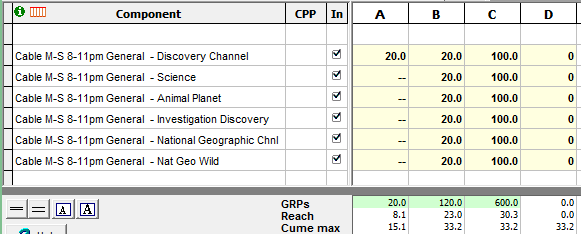Cume Max: The Potential of the Components in a Plan
Potential Audience and Cume Max
At a moment in time, or averaged across the minutes of a program, a telecast may have an audience of, say, 2%. Your commercial is a moment in time, so that's the audience you would get with one spot. But it may be that 5% of people would truthfully answer that they saw at least some part of the program. Many people watch only a part of a program, start late, or switch out early.
The same is true for dayparts, networks and the whole medium. We can come up with an estimate of the portion of a target that ever watches even once. This is the potential audience, or cume max.
Cume max is a very juicy measure because it sets an absolute upper limit on the reach. It's a ceiling on what's possible. You can never reach someone who never ever ever watches the programs, networks or dayparts you have in your schedule.
"Cume Max" is simply the percentage of people who we could possibly reach, the people who ever watch anything that we are using in the plan. It tells us the maximum possible reach for a set of dayparts.
In TView, you can examine cume max in several places:
| • | in the bottom-line totals in the Table view (see What to Show in the Table View). Also, see the text below. |
| • | in the Details view in the Topline and Contributions Table panels |
| • | a vivid portrayal of the cume max of the elements of your plan in the Contributions Chart |
| • | as a real ceiling in the plan Build Up Curve. |
Cume Max of a Plan
What is the ultimate potential audience that can be achieved using a given daypart or other component or combination of components?
TView makes this easy to determine, by tabulating all of the respondents who have any possibility of being reached with each component in the plan. These people are counted as potentially reachable.
To show cume max within TView, create a plan as usual, and make sure that Cume Max is checked on (see What to Show in the Table View). Consider this example:

Plan A consists of the Discovery Channel alone, and we see (at the bottom) that its cume max is 15.1. In plan B, five more cable networks are added to the plan, and the cume max has jumped to 33.2.
Notice that the reach results is lower. Cume max is the potential of what's possible, telling us about who ever watches any of these networks. But reach tells us about who will actually see our campaign's placement of spots on those networks.
Compare plans B and C: plan C has five times the weight of plan B, and the reach is larger as a result (going from 23.0 to 30.3). But the cume max is the same, 33.2. Our campaign doesn't affect who actually watches the networks.
Finally, look at plan D, where we have zeroes as plan entries. This is enough to tell TView that we want these lines included in the cume max. In plan A, only Discovery was counted, because the entries for the other networks were blanks, not zeroes.
Another fast way to toggle plan lines or whole groups in and out of consideration is to use the "In" checkboxes -- read there for details.
